The
Parilla 250
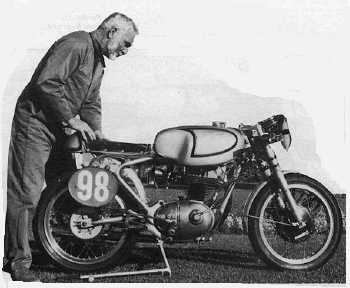
The Parilla motorcycle first appeared in public in 1946 at a local
race meeting held at Lombardy in Italy. It was a single cylinder,
single overhead camshaft four stroke 250cc motorcycle. The bike
performed well enough for the manufacturer Giovanni Parrilla (he
dropped an "r" from his motorcycle names) to construct a series
of 250cc bikes at his Milan workshop. The first 250 Parilla sport
could reach 75 mph and produced 14 bhp, whilst the 250 racer made
18 bhp and had a top speed of 87 mph. The cam was shaft and bevel
driven, much like a Norton and the magneto was mounted behind
the cylinder.
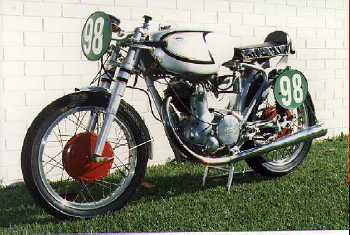
In 1948 Giovanni redesigned his racing motorcycles and installed
twin overhead camshafts. With a bore and stroke of 56 x 72mm and
a compression ratio of 7.8 : 1 the racer made 21 bhp and had a
top speed of 100 mph. This model featured a forward mounted magneto.
Giovanni was an excellent technician and an enthusiast who produced
well engineered and individualistic designs at a time when British
firms were struggling with Villiers engines and pre-war designs.
Despite
the depredations of the war Giovanni was able to develop his designs
so quickly that in 1948 he was able to produce a range of road
machines. There was a 98cc model 125cc and 250cc models and an
experimental 250cc racing twin. The designer of these machines
was an ex-Gilera factory engineer named Salmaggi who had worked
on the famous Gilera Saturno.
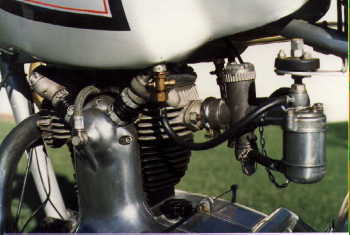
In 1953 a designer called Soncini joined the company and introduced
an improved road range - the Setter 250cc and the Vetro 350cc;
both of these were twin cylinder raCachines. In addition a 175cc
single cylinder, single camshaft model called the Turismo Speciale
was produced. This model featured short pushrods which were operated
by a single cam which was located high on the timing case. By
the simple addition of a high lift camshaft, modified versions
of the 175cc model began to have some success on the race track
in Italy. Giovanni visited the United States in 1954 and a roadtested
175 competition model was soon to prove an eye opener for the
local market, conditioned as it was to Harley Davidsons and British
Twins. In tests in America the 175cc single was timed to a road
speed of 154 kmlh. With such a successful initial impact, an aggressive
sales campaign was launched in the United States in 1957 and racing
Parillas were utilised to generate the publicity. Guiseppi Rottigne
was employed as a works rider in 1958 and despite the disadvantage
of having only 175cc managed to win the 250cc Grand Prix at Daytona.
Other race successes were achieved by Tony Woodman who rode for
Parilla from 1959 to 1963.
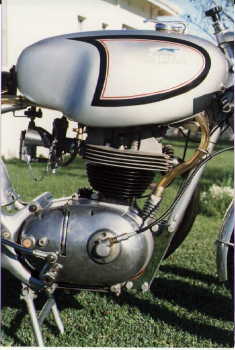
The United States market demanded larger capacity bikes and the
single was enlarged to 200cc in 1959 and in 1960 to 250cc when
road racing, street and scrambler versions were introduced. Success
of sorts came to Parilla in 1963 when Ron Grant finished in the
US Grand Prix at Willow Springs on a 250 Parilla. A world Championship
round was held at Daytona in the same year. Ron Grant succeeded
in ;etainI~hsecond aher Phil Read and Fumio both had trouble with
their Yamahas, only being beaten by Alan Shepherd on a rotary
valve watercooled MZ. Further racing success eluded Parilla from
now on as the all conquering two-strokes became more un-reliable
and as a result the finely engineered single could no longer be
competitive. With money running short and motorcycle sales plummeting,
motorcycle production was suspended by Parilla in 1967.
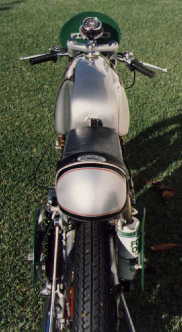
Giovanni, the master craftsman, died soon after in 1968. His son
continued to produce quality' two-stroke go-cart engines, the
first of which had been developed in 1957, but motorcycle production
ceased. Despite
the odds a rare and pristine example of Parilla's most successiul
racing model has been maintained by Cecil White. Previously owned
by talented artist Alan Puckett the Parilla was imported from
the United States after being restored by Earl Workman. This example
was originally a work's racing model which produced 34 bhp at
10 000 rpm and had a top speed of 185 kmh. Cecil quotes Alan Puckett
as saying that the work's motor is very sharp.
The
Parilla racing motor is clean, highly polished and uncluttered.
The gearbox is in - unit and the design is modern looking and
in excellent condition. There are no rough edges anywhere in sight
and the fine engineering expected of the Italian craftsman is
clearly evident. In the interests of preserving the genuine Work's
motor a Grand Sports Wildcat Scrambler motor has been fitted.
Alan Puckett had the Grand Sports motor as a spare and could not
resist fitting a brand new motor to a Classic Racer.
This
engine makes 27 bhp at 9500 rpm and runs on a 9.5 : 1 compression
ratio. The bore and stroke of 68 x 68mm is fed by a 28mm Dell'orto
carburettor with a remote rubber mounted float and the motor is
capable of propelling the bike at 175 kmh. Looking at the bike
one is struck by the overall small dimensions, the narrow scalloped
tank and the clean uncluttered lines of the motor. The engine
features a large alloy finned head and a high mounted camshaft
which is chain driven from the crank. The rockers are actuated
by short (50mm) pushrods and are set parallel to the crankshaf.
The pushrods are thoughtfully enclosed in rubber boots and the
overhead valves are controlled by hair-pin valve springs. This
short mechanism allows for high revs and also allows the head
to be removed without disturbing ignition timing.
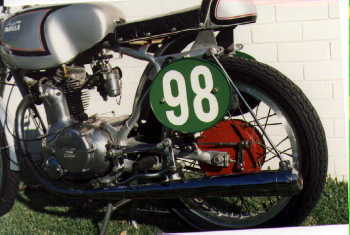
The frame is a single down tube design with the engine forming
a stressed member of the design. The double cradle rear sub-frame
supports a twin shock swinging arm. The rear shocks are made by
Mulholland and are not an original fitting. The front forks are
made by Mote Parilla and whilst having only short travel appear
to be very solid and resistant to flex.
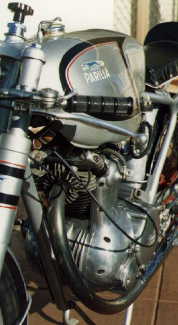
The Parilla is reputed to be a very tractable bike and will pull
strongly from 2000 rpm to 8000 rpm with a stirring exhaust note.
The four speed gearbox operates in a similar pattern to British
bikes with a right-hand foot change using up for Ist and down
for second and on to top gear.

